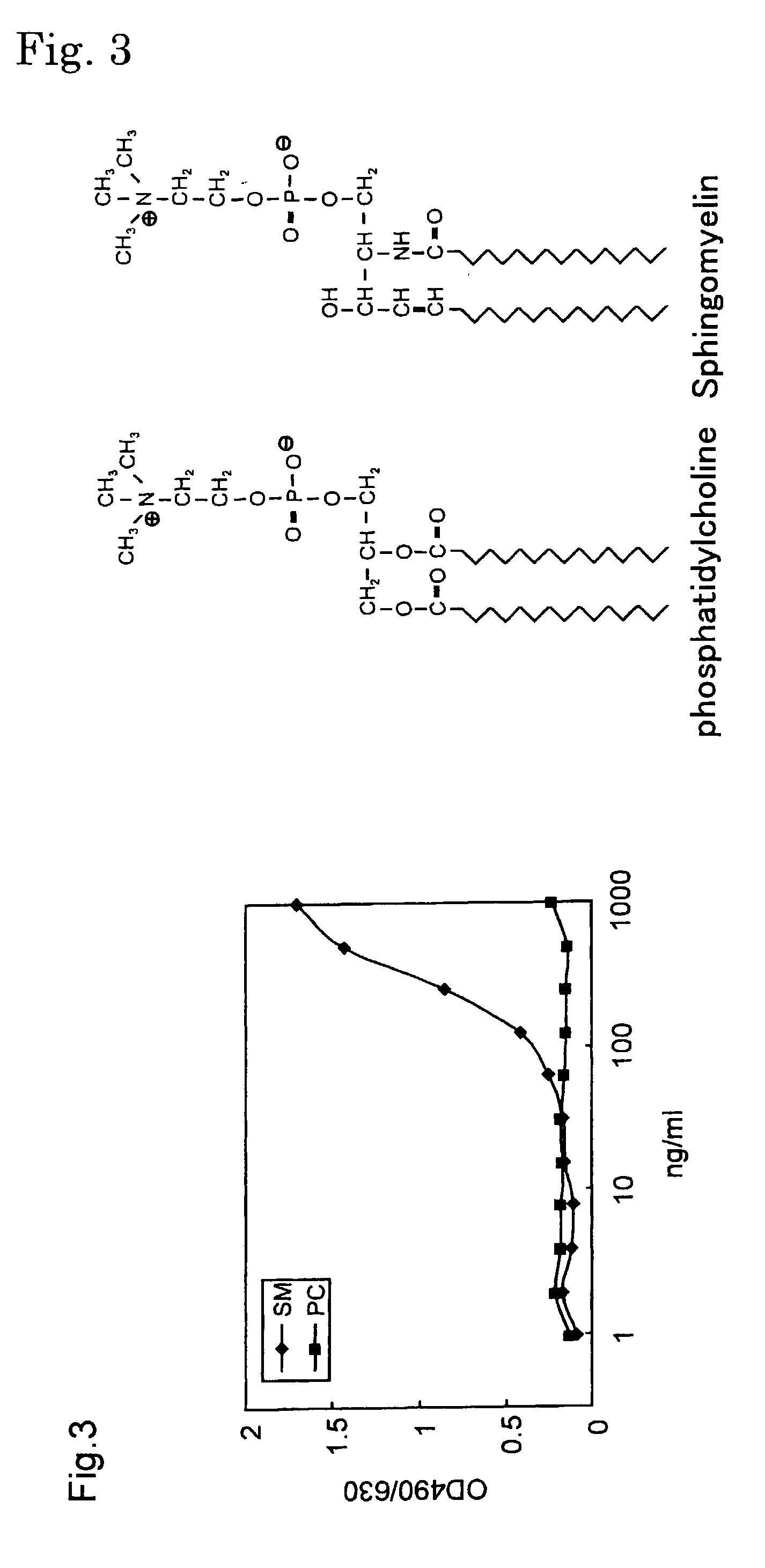Sphingomyelin detecting probe
a sphingomyelin and probe technology, applied in the field of sphingomyelin detecting probes, can solve the problems of not being able to use lysenins which have been reported before, not being able to put them to practical use as sphingomyelin detecting probes,
- Summary
- Abstract
- Description
- Claims
- Application Information
AI Technical Summary
Benefits of technology
Problems solved by technology
Method used
Image
Examples
example 1
[0099] (A) Cloning of cDNA of earthworm toxin Lysenin
[0100] Cloning of cDNA of earthworm toxin Lysenin has been already reported (Sekizawa, Y., Kubo, T., Kobayashi, H., Nakajima, T., and Natori, S. (1997), Molecular cloning of cDNA for lysenin, a novel protein in the earthworm Eisenia foetida that causes contraction of rat vascular smooth muscle. Gene 191, 97-102). Also, the nucleotide sequences of Lysenin 1 and Lysenin 3 are registered in a database (Lysenin 1: GenBank85846; and Lysenin 3: GenBank85848). The nucleotide sequence and the amino acid sequence of Lysenin 1 are shown in SEQ ID NO: 1 in Sequence Listing, and the nucleotide sequence and the amino acid sequence of Lysenin 3 are shown in SEQ ID NO: 2 in Sequence Listing.
[0101] (B) Production of MBP-Lysenin 1-3
[0102] (1) Production of pMBP-Lysenin 1, pMBP-Lysenin 3
[0103] In the amplification by PCR, the following primers in which the 5'-terminus is BamHI site and the 3'-terminus is HindIII site were prepared for both Lysenins...
example 2
[0122] (A) Cloning of CDNA of earthworm toxin Lysenin
[0123] Cloning of cDNA of earthworm toxin Lysenin has been already reported (Sekizawa, Y., Kubo, T., Kobayashi, H., Nakajima, T., and Natori, S. (1997), Molecular cloning of cDNA for lysenin, a novel protein in the earthworm Eisenia foetida that causes contraction of rat vascular smooth muscle. Gene 191, 97-102). Also, the nucleotide sequence of Lysenin 1 is registered in a database (GenBank85846). The nucleotide sequence and the amino acid sequence of Lysenin 1 are shown in SEQ ID NO: 1 in Sequence Listing.
[0124] (B) Method for producing MBP-Lysenin 118-297
[0125] In amplification by PCR, the following primers capable of amplifying a fragment which is equivalent to amino acids 118-297 in Lysenin 1 (containing nucleotides 351-894 in the nucleotide sequence) and has BamHI site at the 5'-terminus and HindIII site at the 3'-terminus, were prepared.
[0126] Lysenin 118 forward: ttcggatccctgaatgxtgacgttggtgga (SEQ ID NO: 11)
[0127] Lysenin...
PUM
| Property | Measurement | Unit |
|---|---|---|
| Length | aaaaa | aaaaa |
| Length | aaaaa | aaaaa |
| Length | aaaaa | aaaaa |
Abstract
Description
Claims
Application Information
 Login to View More
Login to View More - R&D
- Intellectual Property
- Life Sciences
- Materials
- Tech Scout
- Unparalleled Data Quality
- Higher Quality Content
- 60% Fewer Hallucinations
Browse by: Latest US Patents, China's latest patents, Technical Efficacy Thesaurus, Application Domain, Technology Topic, Popular Technical Reports.
© 2025 PatSnap. All rights reserved.Legal|Privacy policy|Modern Slavery Act Transparency Statement|Sitemap|About US| Contact US: help@patsnap.com



